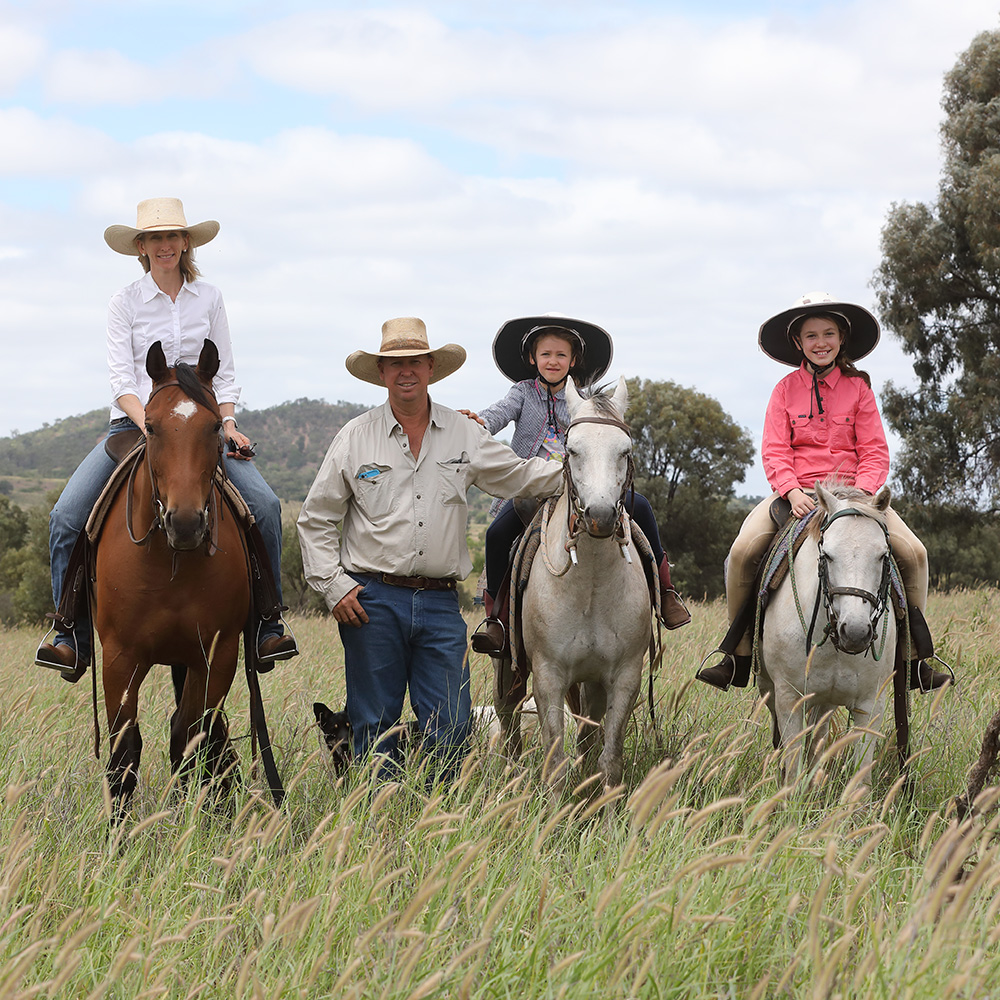PRODUCER CASE STUDY
Brett & Pip Krafft
Rainbow Hill, THANGOOL
Striking the fine balance of matching stocking rates to carrying capacity while building groundcover is no easy feat, but it’s a key goal a family of Central Queensland beef cattle producers is achieving.
Introduction
Brett and Pip Krafft, ‘Rainbow Hill’, Thangool, and their young daughters, run 500 head of breeding and trade cattle, targeting a turn-off weight of 400kg to supply predominantly to the feedlot sector.
Two years ago, they signed on to participate in the ground-breaking Project Pioneer – a collaboration between the Australian Government, Resource Consulting Services (RCS), WWF, CQUniversity, Maia Technology, Farm Map 4D and beef producers throughout Queensland’s Great Barrier Reef catchments.
It’s a decision Brett and Pip say has helped them to not only identify targets and a clear direction for their business but access support to help them implement plans to achieve those goals.
Good grazing management and optimising pasture use has been a focus for the Kraffts, as they have set about making on-farm changes at ‘Rainbow Hill’ and another nearby property they run as one aggregation, totalling 810 hectares.
For the Kraffts, the impacts of those changes have been significant in their business and landscape.
“We saw Project Pioneer as a great opportunity to create a viable, profitable business for us that would give us what we needed as a family,” Pip said.
“We were already aware of, and admired, RCS’s principles, motivations and programs so to have an opportunity to do the Executive Link program through Project Pioneer was fantastic.
“Grazing management and improving soil and water health was always high on our list of priorities, but being part of this program has meant we really have been able to identify milestone targets and access a lot of resources to create possibilities.
“We’re not inheriting an established family business and we’re not part of a larger family business, we’re basically starting from scratch. With debt and financing it’s not easy, so being able to access resources and knowledge is very important for us. To be able to increase scale, we needed the support that RCS and Project Pioneer have provided.”
Path to change
Brett said a key to achieving their on-farm goals has been to undertake major water infrastructure and fencing programs.
“We really ramped up splitting up our country, resting our country and trying to build a better soil profile, which leads to better groundcover,” Brett said.
“Before we commenced the project, we were grazing half and resting half of our paddocks, and had five watering troughs. We mostly relied on dams and springs in the creek for stock water. We now have 90% of our paddocks resting at any time, and have installed an extra 18 troughs, which means our stock no longer use surface water.
“We’ve split up all our major paddocks and spread watering points out, enabling us to rest paddocks as we rotate our cattle.
“We have always rotated our cattle but not to the degree that we are now. We’re aiming for 100% groundcover at all times and to improve grass quantity and quality – the only way to do that is by resting paddocks and then adding livestock for short grazing periods.
“The landscape here is undulating with improved scrub soils and forest soils, and a mix of native grasses. When we first started Project Pioneer, we might have had 60% to 70% groundcover. We have improved that and maintained it through the dry period that we’ve experienced this year.
“We also have major creek systems running through the properties – some have permanent water holes and a few springs, but all of them feed into the Kariboe and Kroombit Creeks which then flow into the Dawson River and eventually into the Fitzroy River, and then out into the Great Barrier Reef.
“One of the biggest impacts of the project for me is that it changes the way you look at things, especially water. I think we both comment, when we see water running, what colour is it? How much soil is in it?
“We noticed our dam starting to dry up, and I initially put it down to a series of dry years, when in fact we have improved our water penetration. Water is staying on our land and that water retention is resulting in less run-off.”
Pip said their on-farm changes had also facilitated one of their biggest achievements – matching stocking rates to carrying capacity.
“It always seems like an obvious, foregone conclusion that beef producers are doing that, but I think it’s very hard to achieve,” Pip said.
“Although you have a long-term benchmark, the carrying capacity of your property changes constantly with seasonal conditions. If cattle numbers are static year after year, regardless of season, the land system will end up degraded through overstocking, and the time it takes for that land system to recover from overstocking is usually at least two to three good seasons, if at all, which equals lost productivity to the business.
“Our goal is to match stocking rates to carrying capacity and we feel we’re doing that very well.
“Resting paddocks is a big innovation – allowing the grass to recuperate, grow and respond. As a result, we have increased our long-term benchmark carrying capacity and we’re able to run more stock numbers than we did five years ago.
“As part of Project Pioneer, we have a subscription to the online grazing management tool Maia Grazing, which we use to record what we’re doing and plan for what’s ahead, to forecast, and then make decisions.”
Having the tools to plan ahead has also empowered the Kraffts with a greater feeling of control in an industry so reliant on the vagaries of weather and market prices.
“We are constantly aware of where we are in terms of grass availability, and seasonal conditions. We’re very on top of what’s happening and we forecast what’s going to happen, according to different rainfall scenarios,” Pip said.
“We’re very aware of where we are at any point in time and we always have a couple of options up our sleeve as to which way we’ll go, depending on what plays out with seasonal conditions and markets.
“We feel we’re much more proactive than reactive now.”
Overcoming obstacles
The path to change is rarely completely smooth, however, the ongoing support from RCS through Project Pioneer has been crucial for Brett and Pip.
“A big challenge or obstacle for us is debt and financing. We haven’t yet overcome that but we have the resources to create a plan,” Pip said.
“We’ve been able to think outside the box and had opportunities through the project and externally that have enabled us both to access off-farm income.
“That has enabled us to maintain the business through change. Often there will be a period where cash flow is low, but I feel that we’ve overcome that through off-farm income very successfully.”
“Succession has also been a big thing for us lately, centred around an opportunity to access more land to expand our business, and to help family members through change. We’ve been able to navigate our way through that process thanks to Project Pioneer,” Brett said.
“Through Project Pioneer, we’ve come up with different scenarios and different ideas to enable all parties to come to an agreement.
“We’re in the final implementation stages now and it looks like a win-win for everyone.
“We overcame that through the resources of the Executive Link board and RCS staff, tossing ideas around the table and hearing about and learning from other people’s experiences.”
The bigger picture
Like many primary producers, the Kraffts are acutely aware that what they do on-farm has a ripple effect well beyond their boundary fence.
Having achieved significant changes in their business, they’re keen to show other producers the impact of the improvements they have made.
“We’d like to help spread knowledge of good land management practices throughout the catchment,” Pip said.
“It’s incredibly important to create and maintain prosperous, productive communities, and good land management is a cornerstone of flourishing communities; poverty and hardship are extremely detrimental to the environment and, equally, depleted land cannot sustain successful communities. If you have prosperous, successful people, the environment is also going to prosper.
“For me the Great Barrier Reef has always been really important. My family has been involved in catchment management in various places in eastern Australia, and we are all passionate about waterways and water quality.
“Not long after we found out we were successful with our application for Project Pioneer, we went on a holiday to Pumpkin Island and it was great to be able to tell our daughters what we were doing.
“We explained that it would take time and effort, but what they could see around them when we went snorkelling would benefit from it.”
“The widespread drought across NSW has really brought it home for me that more initiatives like Project Pioneer need to happen,” Brett said.
“The way the land has suffered from over-stocking in the drought, to the huge mental strain that these people have gone through and are still going through. Projects like this can help everyone to make the right decision at the right time and be proactive.
“The message needs to be, have a look at what you’re doing now and I guarantee you’ll be harming something, whether it’s the environment or your business.
“Have an open mind, seek education, but most importantly, act on it.”

GET IN TOUCH
Want to talk more about Project Pioneer, or how RCS can help you deliver industry-leading results?




Project Pioneer is funded by the partnership between the Australian Government’s Reef Trust and the Great Barrier Reef Foundation. The project is delivered by RCS with support from WWF, Maia Technology, Farm Map 4D and CQUniversity.




